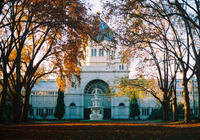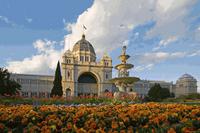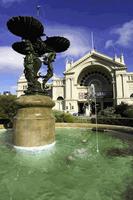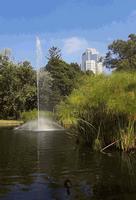You are in: Oceania -> Australia -> Royal Exhibition Bui... , and traditional search or Image Gallery will yield results of this site only
Royal Exhibition Building and Carlton Gardens
| Site number: | 1131 |
|
| Type of site: | Cultural | |
| Date: | 1880-1888 | |
| Date of Inscription: | 2004 | |
| Location: | Australia, Melbourne, Victoria | |
Up to 75 images are shown here. Click on each for more details or on Image Gallery for more images.
| Description: | Built for the great international exhibitions of 1880 and 1888 in Melbourne, Joseph Reed designed the grounds and buildings of the Royal Exhibition Building and the encircling Carlton Gardens. Reed synthesized Byzantine, Romanesque, Lombardic and Italian Renaissance style elements, and for the construction chose to use the combination of brick and timber, steel and slate. The site is typical of the international exhibition movement, where exhibitions shared a common theme and goals: to outline material and moral progress through displays of industry from all nations. The movement saw 50 exhibitions between 1851 and 1915 (venues included Paris, New York, Vienna, Calcutta, Kingston (Jamaica) and Santiago in Chile). --WHMNet paraphrase from the description at WHC Site, where additional information is available. | |
| The Royal Exhibition Building is located in Melbourne, Australia. It is located in the Carlton Gardens, at the north-eastern edge of the central business district. It was the first building in Australia to be awarded UNESCO World Heritage. It sits adjacent to the Melbourne Museum; and is the largest item in Museum Victoria's collection. The Carlton Gardens is a World Heritage Site located on the northeastern edge of the Central Business District in the suburb of Carlton, in Melbourne, Victoria, Australia. The 26 hectare (64 acre) site contains the Royal Exhibition Building, Melbourne Museum and Imax Cinema, tennis courts and an award winning children's playground. The rectangular site is bound by Victoria Street, Rathdowne Street, Carlton Street, and Nicholson Street. From the Exhibition building the gardens gently slope down to the southwest and northeast. According to the World Heritage listing the Royal Exhibition Buildings and Carlton Gardens are "of historical, architectural, aesthetic, social and scientific (botanical) significance to the State of Victoria." The gardens are an outstanding example of Victorian era landscape design with sweeping lawns and varied European and Australian tree plantings consisting of deciduous English oaks, White Poplar, Plane trees, Elms, Conifers, Cedars, Turkey Oaks, Araucarias and evergreens such as Moreton Bay Figs, combined with flower beds of annuals and shrubs. A network of tree lined paths provide formal avenues for highlighting the fountains and architecture of the Exhibition building. This includes the grand allee of plane trees that lead to the exhibition building. Two small ornamental lakes adorn the southern section of the park. The northern section contains the Museum, tennis courts, maintenaince depot and curator's cottage, and the children's playground designed as a Victorian maze. --Wikipedia. Text is available under the Creative Commons Attribution-ShareAlike License. | ||
| Source: | http://whc.unesco.org/en/list/1131 | |
| Reference: | 1. UNESCO World Heritage Center, Site Page. | |






























